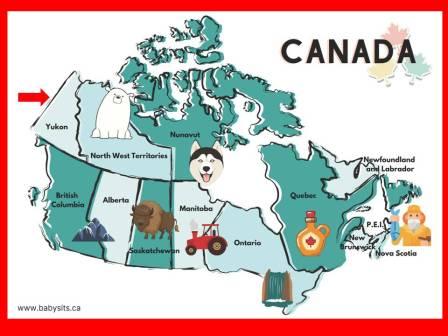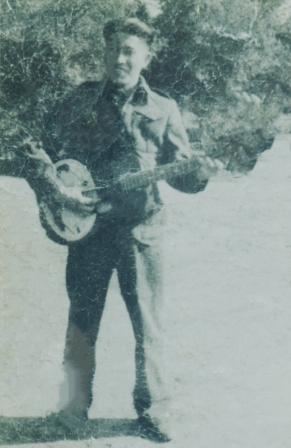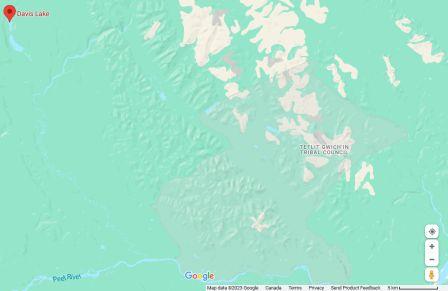September 30, 2023. With an extensive photo wish list from the Canadian War Cemeteries in The Netherlands, it can be difficult for Pieter to determine who will be next in line for his research. But when we learned there is one soldier from the Yukon Territory buried in the Canadian War Cemetery in Holten, and he was on the photo wish list, we knew he was a priority.
Henk Vincent, one of the research volunteers at the Information Centre in Holten, explained that “…Harry Davis is the only Yukon Territory soldier buried in Holten, which is not surprising when you realize that although the Yukon Territory is about the size of Spain in terms of area, it had less than 10,000 inhabitants in 1945….”

Yukon is in northern Canada. (Map source: http://www.babysits.ca)
Yukon is not only in the far northern part of Canada, but on the opposite coast from where we live in Prince Edward Island.
The search for a photo of Harry Henry DAVIS, born December 9, 1921 in Selkirk, Yukon Territory, son of Harry and Grace (nee Woods) Davis, began with an online search.
…Chief Roberta Joseph from the Trʼondëk Hwëchʼin First Nation commemorated Harry …
A CBC article from November 8, 2022 immediately came up: ‘Trʼondëk Hwëchʼin soldiers honoured at annual event in Dawson City’, in which Chief Roberta Joseph “…shared a story that her grandmother would tell her every Remembrance Day when she was growing up.
‘She would always remember her cousin Harry Davis,’ Joseph said. ‘She would always talk about how he sacrificed his life for his platoon. He passed away in World War Two. He let his platoon go ahead so that they could escape the enemy and he stayed behind by throwing a grenade and got caught up in that.’…” (See https://www.cbc.ca/news/canada/north/tr%CA%BCond%C3%ABk-hw%C3%ABch%CA%BCin-soldiers-honoured-at-annual-1.6644908)
 From this one article, we learned that Harry Davis was Indigenous. His mother was a member of the Tr’ondëk Hwëch’in (loosely translated as ‘people of the river’), a First Nation whose members are descendants of the Hän-speaking people who have lived along the Yukon River for millennia. (See https://en.wikipedia.org/wiki/Tr%CA%BCond%C3%ABk_Hw%C3%ABch%CA%BCin_First_Nation)
From this one article, we learned that Harry Davis was Indigenous. His mother was a member of the Tr’ondëk Hwëch’in (loosely translated as ‘people of the river’), a First Nation whose members are descendants of the Hän-speaking people who have lived along the Yukon River for millennia. (See https://en.wikipedia.org/wiki/Tr%CA%BCond%C3%ABk_Hw%C3%ABch%CA%BCin_First_Nation)
…The Trʼondëk Hwëchʼin First Nation provided a photo of Harry …
Chief Joseph was contacted, and shortly afterwards, a photo of Harry Davis was received from Sue Parsons, Collections Manager, Heritage, of the Tr’ondëk Hwëch’in Government. “…I received a request to forward the attached photograph of Harry Davis to you. Mähsi…” she wrote. Sue explained that the photo was courtesy of Martha Kates private collection, “…a family member of Harry Davis….”

Harry Henry Davis. (Photo courtesy of Martha Kates Private Collection)
Harry was orphaned young, as his father died in 1926, and his mother in 1927. Henk noted that “…Harry grew up in the First Nations Reservation of Fort Selkirk in the Yukon Territory, located on the Yukon River, a few hundred kilometres from the Arctic Circle….” His half-sister, Mary Isabel Harriet, was listed as his only remaining direct relative on the Estate Form after his death.
…Harry enlisted in 1942…
After finishing school Harry worked in the Triangle Cafe in Dawson City, Yukon Territory. At the time of his enlistment with the No. XI District Depot on February 19, 1942 in Dawson, he was working as a driver for Yukon Consolidated Gold Corporation.
On March 16, 1942, Harry was sent to No. 110 Canadian Army Basic Training Centre (CABTC) in Vernon, British Columbia for his basic training. A few weeks later, however, he ended up in the Vernon Military Hospital for almost a month with measles, followed by mumps.
After being discharged from hospital on May 7, 1942, and completing his basic training, Harry was transferred to A-4 Canadian Artillery Training Centre (CATC) in Brandon, Manitoba on June 10, 1942, for training as a gunner.
…Harry was sent overseas and assigned to the 8th LAA Regiment…
On July 22, 1942 Harry was on his way to the United Kingdom, on ‘Special Duty’, arriving a week later, and attached to No. 3 Canadian Artillery Reinforcement Unit (CARU), where he received more training.
On November 27, 1942, Harry was assigned to the 8th Canadian Light Anti-Aircraft Regiment, Royal Canadian Artillery. On January 6, 1943 Harry qualified as a driver i/c (W), meaning he was qualified to drive heavy trucks and armoured cars.
On July 20, 1944, Harry left with the 8th Canadian Light Anti-Aircraft Regiment for France aboard the Malayan Prince. (See https://uboat.net/allies/merchants/ship/1768.html)
According to the war diary for July 26, 1944, “… we arrived at the anchorage at Juno Beach, off Courselles-Sur-Mer, at 1600 hours. We don’t expect to get off ship until sometime tomorrow so everyone is taking advantage of the fine weather and sun bathing on the decks…”
The interlude didn’t last, as the war diary for July 27, 1944 stated that “…during the early hours of the morning we were treated to quite an anti-aircraft barrage some miles inland…” After landing, the Regiment moved up through France.
…Allied patrols across the Maas River were dangerous …
On September 19, 1944, Harry was transferred to the Lake Superior Regiment (Motor), joining them as the Regiment advanced “…through France, Belgium and the south of the Netherlands…”
Henk noted that during “… the winter of 44/45, the Lake Superior Regiment, together with other Canadian regiments, was tasked with guarding the northern front line, in this case the Maas River. Patrols were also regularly deployed across the Maas to reconnoitre enemy positions. This often led to violent confrontations with the Germans….”

Harry Davis was badly wounded during a patrol near Kerkdriel. (Map source: DuckDuckGo)
The Lake Superior Regiment was in the area of ‘s-Hertogenbosch, The Netherlands in January 1945. The Regiment’s war diary for January 14, 1945 recorded that at 2:00 am “…a recce patrol under the command of Lt. D.A. Johnson left to cross the Maas in two boats. The first boat contained a beach party of 1 N.C.O., 1 sergeant, and 6 men, the second boat contained the recce group of 1 officer, 1 sergeant, and 5 men…” N.C.O. refers to non-commissioned officer.
“…Due to a heavy fog on the river, the beach party became lost and returned to the start point after some difficulty with the strong current.…” The recce group landed, but the beach party was nowhere to be found.
Lt Johnson decided to proceed with the patrol anyways. As the group moved east towards the town of Kerkdriel, they “…heard an enemy patrol coming down the road toward them…” The group moved to “…the east side of a house in the hope that the enemy patrol would continue down the road, and could be engaged …”
Instead, they were ambushed. “…The enemy patrol, however, came through a copse to the left and rear of our patrol, who immediately engaged them, killing one and wounding two others…”
…Harry was the patrol’s only casualty …
There was one casualty from the recce party. “…One of our men K-76942 Pte DAVIS H.H., was killed and had to be left behind. Lt. Johnson and the remaining scout made a run for it and managed to escape and contacted the covering party. Artillery fire was called down and the patrol returned to our side without further mishap….”
However, Harry hadn’t been killed. He was badly wounded and taken prisoner of war. Unfortunately, he died the following day, Monday, January 15, 1945. He was 23 years old.
…Harry’s sister received a letter with a statement from Lt Johnson…
A February 26, 1945 letter from Colonel R.T.E. Hicks-Lyne, Acting Director of Records for Adjutant-General, to Harry’s sister Mary, quoted a statement from Lt Johnson: “…Private Davis received a burst of 9 m.m. automatic fire, which ignited a # 80 smoke Grenade, carried on his belt. I, the patrol commander, was approximately six feet away from him as at the time. After the explosion I attempted to engage the enemy from the opposite side of the haystack; coming back Lance Sergeant Burrison said: ‘Davis is dead, a grenade is burning in his side.’ As it was an extremely dangerous situation we decided to get out as fast as possible…”
Colonel Hicks-Lyne went on to note that “…This statement is also corroborated by Sergeant Burrison, who was also with your brother at the time…”
…Harry is buried in the Canadian War Cemetery in Holten…
Harry was temporarily buried in the Catholic Cemetery in Kerkdriel. We had wondered who had initially buried him – the Canadians or the Germans. Henk explained that “…since Harry Davis became a prisoner of war on January 14, 1945 and died on January 15, while Kerkdriel was only liberated on April 23, we can assume that he was buried by the Germans…”
On August 2, 1946, Harry was reburied in the Canadian War Cemetery in Holten, The Netherlands.

Grave of Harry Henry Davis at the Canadian War Cemetery in Holten. (Photo courtesy of Canadian Virtual War Memorial)
….Davis Lake in Yukon Territory is named in Harry’s honour…..

Davis Lake in Yukon Territory is named after Harry Henry Davis. (Map source: Google maps)
Harry has been honoured by having Davis Lake in Yukon named after him. (116I01- 66° 10’ 37”- 136° 24’ 57”)
Thank you to Roberta Joseph and the Trʼondëk Hwëchʼin government for providing a photo of Harry. Thank you also to Henk Vincent for additional information on the patrols made along the Maas River and letting us know that Harry Davis was the only soldier from the Yukon buried in Holten.
Do you have a story to tell? Pieter encourages you to email him at memorialtrail@gmail.com, comment on the blog, or tweet to @researchmemori1.
© Daria Valkenburg
…Want to follow our research?…
If you are reading this posting, but aren’t following our research, you are welcome to do so. Our blog address: https://onthewarmemorialtrail.com/
 4 countries, 6 weeks, 7,000 km – an unforgettable war memorial journey in Europe…. Daria’s book ‘No Soldier Buried Overseas Should Ever Be Forgotten‘ is available in print and e-book formats. Net proceeds of book sales help support research costs and the cost of maintaining this blog. For more information see https://nosoldierforgotten.com/
4 countries, 6 weeks, 7,000 km – an unforgettable war memorial journey in Europe…. Daria’s book ‘No Soldier Buried Overseas Should Ever Be Forgotten‘ is available in print and e-book formats. Net proceeds of book sales help support research costs and the cost of maintaining this blog. For more information see https://nosoldierforgotten.com/
Subscribe to our YouTube Channel: On The War Memorial Trail With Pieter Valkenburg: https://www.youtube.com/channel/UCJ591TyjSheOR-Cb_Gs_5Kw.
Never miss a posting! Subscribe below to have each new story from the war memorial trail delivered to your inbox.